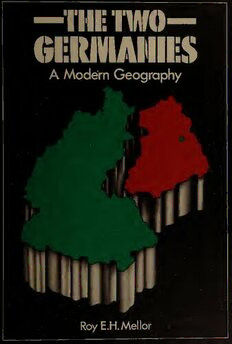
The Two Germanies: A Modern Geography PDF
Preview The Two Germanies: A Modern Geography
rwo ■ I A Modern Geography Roy E.H. Mellor, i\c / 3Lfc(o»C. NIAGARA UNIVERSITY LIBRARY Copyright © 1978 Roy E. H. Mellor All rights reserved First published 1978 Harper & Row Ltd 28 Tavistock Street London WC2E 7PN No part of this book may be used or reproduced in any manner whatsoever without written permission except in the case of brief quotations embodied in critical articles and reviews. British Library Cataloguing in Publication Data Mellor, Roy Egerton Henderson The Two Germanies. 1. Germany - Economic conditions - 1945 - I. Title 330.9’43’087 HC286.6 Published in the U.S.A. 1978 by Harper & Row Publishers, Inc. Barnes & Noble Import Division ISBN 0-06-494778-5 ISBN 0-06-494779-3 Pbk Designed by Richard Dewing ‘Millions’, London Phototypeset by Tradespools Ltd, Frome, Somerset Printed by The Pitman Press, Bath, Avon CONTENTS Preface V Introduction vi Part I The Foundations 1 Chapter 1 The German Lands - The Geographical Setting 3 Chapter 2 Territorial Evolution from 1815 31 Chapter 3 Economic Change 49 Chapter 4 Population and its Problems 1815-1945 102 Chapter 5 The Hard Years 1945-1950 126 Chapter 6 Economic Collapse and Reconstruction 1945-1950 142 Part II The Two German States of the 1970s 167 Chapter 7 The Two German States: Some Introductory Comparisons and Contrasts 169 Chapter 8 The German Federal Republic: Territory and Population 183 Chapter 9 Industry in the Federal Republic: Energy 208 Supply Chapter 10 Industry in the Federal Republic: Iron and Steel, other Metals and Chemicals 226 Chapter 11 Industry in the Federal Republic: Engineering, Textiles and Food Industries 243 Chapter 12 The Tertiary Sector in the Federal 266 Republic Chapter 13 Farming and Forestry in the Federal Republic 281 Chapter 14 Transport in the Federal Republic 308 Chapter 15 The Lander and their Regional Problems in the Federal Republic 325 Chapter 16 The German Democratic Republic: The State and its Population 353 Chapter 17 Industry in the German Democratic Republic 368 Chapter 18 Agriculture and Forestry in the German Democratic Republic 390 Chapter 19 Transport and the Tertiary Sector in the German Democratic Republic 405 Chapter 20 Berlin - The Divided City 417 Postscript Prognosis for the Future of the Two German States 429 Bibliography 432 Index 449 T PREFACE My interest in Germany began in the years of the Third Reich and has remained through the great changes that have followed. Over such a span of time, an observer like myself becomes much impressed by the importance of the events, personalities and attitudes that comprise history in influencing the contemporary: it is this experience that has coloured the pattern of this text. It would be difficult to list all the kind people in Britain and in Germany who have tolerated my inquiry and have tried to provide the answers I sought over the years - to them all I say a heartfelt thank you. I am also grateful for help received from the British Council and from the Carnegie Trust for Scotland as well as for the opportunity to spend terms in the Universities of Munster in Westfalen and Bochum. For secretarial assistance in preparing the manuscript I greatly appreciate the help of Mrs. Jane Calder, Miss Christina Morrison, Miss Lily Findlay and Miss Elizabeth Weir. I have also received valuable assistance from Dr. Sheila Bain and Mrs. Irene Greig. The maps have been prepared and drawn by Mr. L. McLean, Mrs. Alison Sandison and Mr. Philip Glennie - their efforts are much appreciated. The work would never have been finished without the untiring assistance of my wife, who has done so many of the more tedious tasks. R.E.H.M. INTRODUCTION We still speak of Germany without usually qualifying to which Germany we are referring. Indeed, among the countries of Europe, Germany has been very much a fluctuating political-geographical unit with a changing pattern of territorial organization. So great have been the upsets and changes of the last hundred and fifty years that it is important to appreciate the historical dimen¬ sion in the contemporary German scene. The great territorial upheavals of Napoleonic times were followed by faltering progress towards political- geographical unity in the Second Reich of 1871: a truly unitary and centralized German state appeared for a mere twelve years in the Third Reich. The Second World War has been followed by the emergence, in an abbreviated overall territorial framework, of two dimensionally and ideologically contrasting German states under outside sponsorship. The nineteenth century, revolutionary in a political, social, economic, and technological sense, witnessed not only a changing political-geographical framework in Germany, but also laid the foundation of social and economic spatial patterns within the borders as drawn in 1815, later modified by both addition and loss. The dislocation caused by territorial loss after the First World War brought subsequent adjustments to and compromises with the new situation, hardly fully assimilated by the spatial structure of society and economy before the outbreak of the Second World War in 1939. Unconditional surrender in 1945, again followed by substantial territorial loss, brought a radical reordering of the nation’s remaining political space. The victorious
